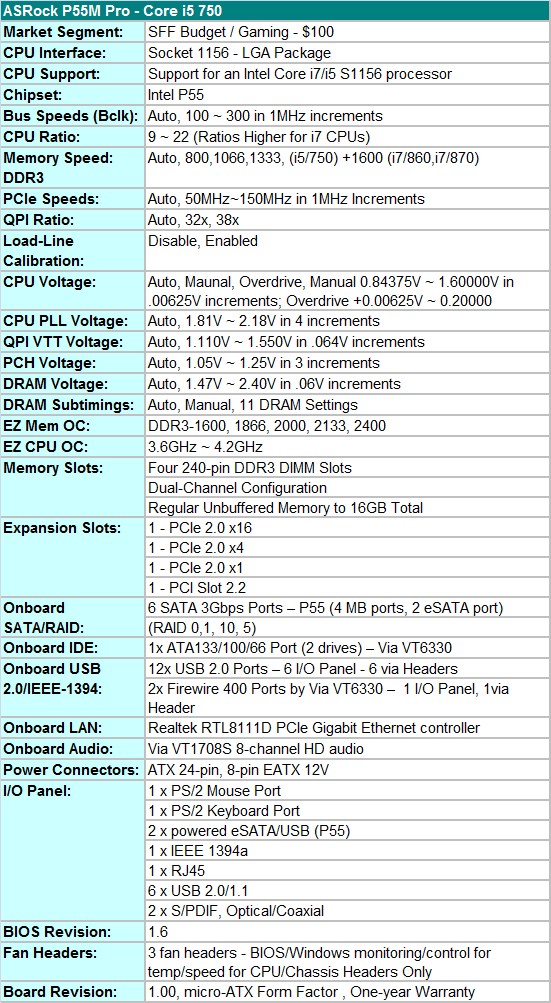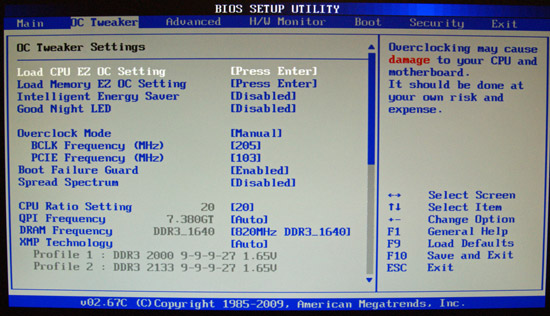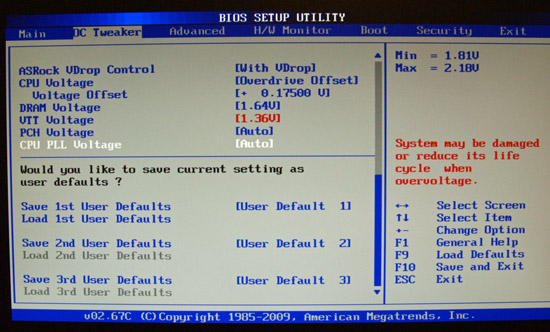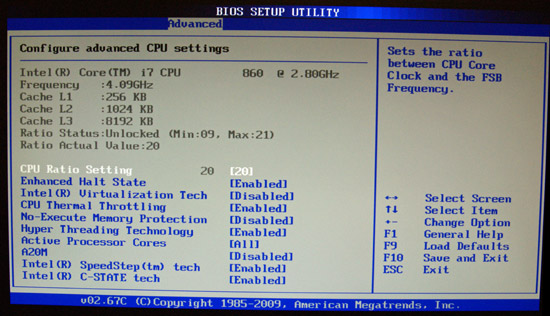Budget Micro-ATX P55 Faceoff: Gigabyte GA-P55M-UD2 and ASRock P55M Pro
by Gary Key on October 5, 2009 12:30 PM EST- Posted in
- Motherboards
Next up is ASRock’s P55M Pro. You can purchase this board for around $100.
ASRock P55M Pro Feature Set

ASRock includes a full featured set of components like the Via VT1708S HD audio codec, Realtek RTL8111D Gigabit LAN controller, Via VT6330 IDE/IEEE 1394a combo chipset, powered eSATA/USB ports on the I/O panel, and full support for the Core i7/i5 S1156 processor series.
ASRock also includes a limited accessories bundle. You get the standard rear I/O panel cover along with 1 x IDE cable, 1 x Floppy cable, 2 x SATA cables, 1 x SATA power cables, an informative manual and quick installation guide, and software CD. We understand the need to cut costs where possible to meet a $100 price target, but including at least one USB 2.0/IEEE 1394a bracket for the headers would have been appreciated.
BIOS
ASRock has designed a BIOS that emphasizes quick auto overclock settings using their CPU or Memory presets rather manually overclocking the board. The breadth of granular BIOS settings in the Gigabyte UD2 board is just not available in the P55M Pro . The BIOS is setup for general overclocking duties and includes the typical P55 settings: CPU multiplier, PCI-E bus, Bclk frequency, memory multipliers, and important voltage options needed for overclocking.
ASRock includes Load Load-Line Calibration (LLC), or they refer to it as With or Without Vdrop. LLC will help to eliminate line droop on the VCore line, but also will cause VCore to overshoot set values when under load. We recommend having LLC disabled in most situations, but if you have to reach a certain overclock for benchmarking, then you should probably enable it. In our case, we enabled when overclocking above 3.8GHz since Vdrop was around -0.05V under load in most cases.
One strength of the BIOS is the auto OC settings that will quickly set the board up for overclocking your memory or CPU to a preset level. Both settings worked well with us favoring the CPU settings as the memory setting at 2133/2400 would drop the CPU multiplier to 13x~15x, resulting in CPU speeds lower than stock with Turbo disabled.
Our only problem with the CPU OC setup is that memory speeds would sometime drop below the capability of our kits with memory speeds running in the 1200MHz range. Those speeds actually do not penalize application performance by more than a couple of percent, but timings followed the SPD of the module. If the SPD is not setup properly, you could end up with CAS 9/10 settings at DDR3-1200. It is easy enough to change them but you end up defeating the purpose of a quick OC.
Voltages tended to range on the high side with the CPU auto OC settings. We understand the reasoning as the ranges needed to ensure stability across a wide variety of processor capabilities require running VCore/VTT a little higher than our CPU’s capabilities. This is the one drawback to preset settings utilized by Gigabyte and ASRock instead of auto overclocking routines based on actual component capabilities that ASUS utilizes. The good news is that on the CPU side, our system always reached the presets and was perfectly stable. Using the memory presets above DDR3-2000 resulted in a few lockups, especially with memory that had not been tested by ASRock.
ASRock has finally implemented BIOS flashing within the BIOS. Instant Flash can read files directly from a USB flash or hard drive making BIOS updating a simple and safe procedure. We tried this feature 30 times as part of our testing routine and it never failed.
We did have a couple of slight disappointments with the BIOS. In the voltage setting options, ASRock does not provide granular voltage settings in the same way that Gigabyte does on the UD2 board. The settings provided will allow for quick and easy overclocks to the 4.1GHz range. Practically speaking, that is probably a level we would not exceed in a 24/7 desktop to be honest.
However, it was a limiting factor in overclocking this board compared to the Gigabyte offering. The main culprit was the lack of VTT voltages between 1.36V and 1.42V. We feel that exceeding 1.40VTT could create a long term problem with Lynnfield CPUs. Intel’s guidance is still 1.35V as the recommended maximum, if not lower in most cases with these CPUs. We needed around 1.39V on VTT to ensure stable operation with our processors above 4.1GHz, we just would not run the 1.42V setting in the ASRock BIOS on air-cooling for performance improvements that would be minor on a daily basis.
BIOS Information
Let’s take a brief visual look at the BIOS.














55 Comments
View All Comments
Sunburn74 - Monday, October 5, 2009 - link
Thanks.Which board? I searched the thoughts section and don't see any mention of sleep :(
I just know its a huge problem with gigabyte boards, pretty much every p45- and a good number of the x58 boards mysteriosly can't s3 sleep with significant overclocks in place and its something I'm seriously going to explore before my next mobo purchase.
Ryun - Monday, October 5, 2009 - link
I purchased and Asrock 760g, which is a great little motherboard, yet it does not support S3 state (standby mode). I have an email from Asrock's (surprisingly quick-response) tech support saying that none of their boards officially support S3 state and to use their Instant Boot technology instead.Did the Asrock motherboard you tested allow you to go into S3 state/standby mode? I really like Asrock's boards but the lack of standby is a deal breaker for me.
Gary Key - Monday, October 5, 2009 - link
S3 is fully supported on the ASRock board. In the power consumption section I did note what needed to be enabled for it work. Also, this was probably in the wrong spot, but in the OC section I briefly mentioned that the board had no problems resuming from S3 with the Bclk set to 215. I can understand why ASRock wants you to use Instant Boot, but S3 operation is just fine, even when overclocked.Ryun - Monday, October 5, 2009 - link
Ah, looks like I missed that part. Many thanks for pointing that out. Sadly though, I don't have those BIOS options on the 760g board I have but perhaps I can tinker a bit more.n7 - Monday, October 5, 2009 - link
Just wanted to say a massively huge thank you for testing with 8 GB!It's extremely encouraging to see, as the large majority of reviewers do not bother testing with all slots populated.
Thanx again.
vlado08 - Monday, October 5, 2009 - link
Which board has the quickest Power On Self Test?With fast CPU's and SSD I expect fast booting!
Now I have a Gigabyte board (P965 DS4) and when the Sata is in AHCI mode POST is quite long.
I hope that in future articles you will include this information.
MadMan007 - Monday, October 5, 2009 - link
S3 is your friend. Really, who boots their computer every time any more?strikeback03 - Monday, October 5, 2009 - link
I usually do, since I dual boot and won't necessarily know which OS I need the day before.Gary Key - Monday, October 5, 2009 - link
Cold Boot - Quick Boot turned off in BIOS - AHCI enabled, External Hard Drive attached via IEEE 1394a, LAN attached to our Promise NAS via a Gigabit Switch.Time reported is from the time we turn on the board until Win7 has correctly installed the network stack. So this is the full POST and OS is usable process that is being timed.
ASRock - 44.7 seconds
Gigabyte - 53.2 seconds
I have the information since we run this for every board, just did not know if anyone would care to see it. ;)
vlado08 - Tuesday, October 6, 2009 - link
Thanks GaryBut I was interested in time from pushing the power on switch until the begining of the OS loading. I think that there might be difference between boards depending on their BIOS.
Time from begining of the OS loading until fully functional OS depends on the computing power ot the CPU and the speed of the HDD (SSD) and not on the design of the board.
And because you (we) want to distinguish between the boards I thought that this might be one of the criterion.